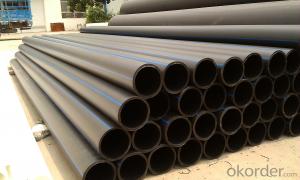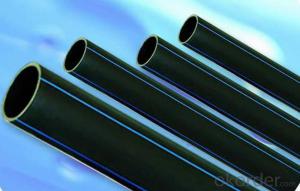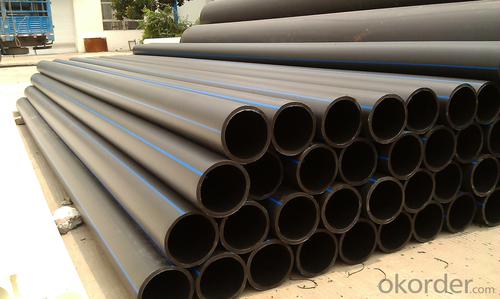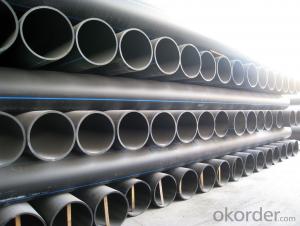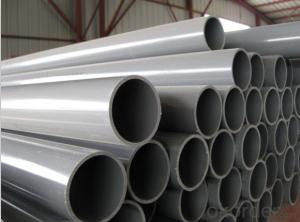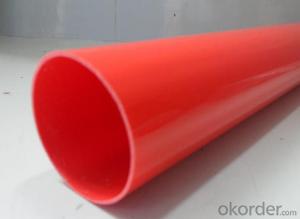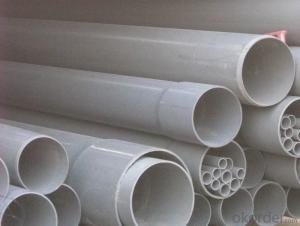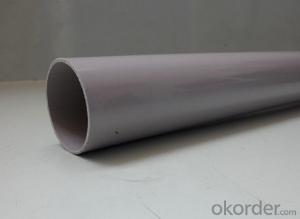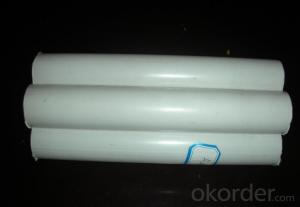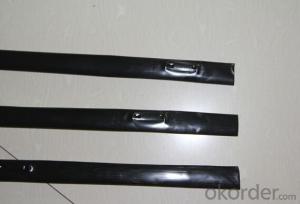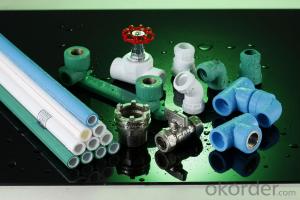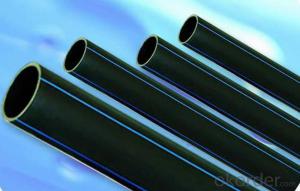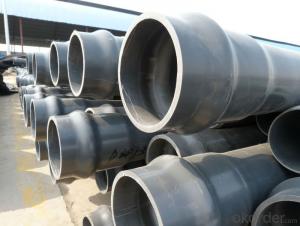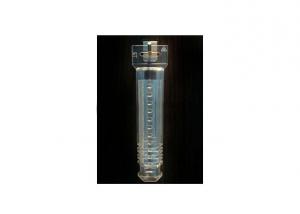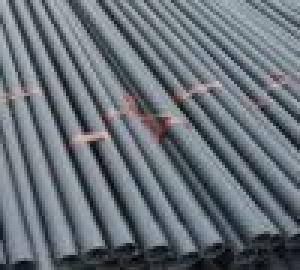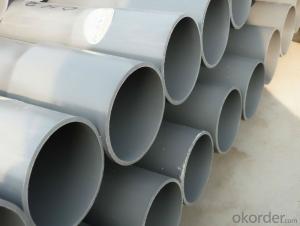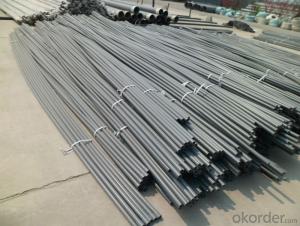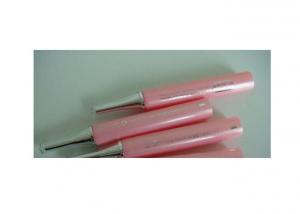Plastic Tubes HDPE Pipe ISO4427-2000 DN160
- Loading Port:
- China Main Port
- Payment Terms:
- TT OR LC
- Min Order Qty:
- -
- Supply Capability:
- -
OKorder Service Pledge
OKorder Financial Service
You Might Also Like
Physical properties[edit]
Polyethylene is a thermoplasticpolymer consisting of long hydrocarbon chains. Depending on the crystallinity and molecular weight, a melting point and glass transition may or may not be observable. The temperature at which these occur varies strongly with the type of polyethylene. For common commercial grades of medium- and high-density polyethylene the melting point is typically in the range 120 to 180 °C (248 to 356 °F). The melting point for average, commercial, low-density polyethylene is typically 105 to 115 °C (221 to 239 °F).it is transprant.
Chemical properties[edit]
Most LDPE, MDPE and HDPE grades have excellent chemical resistance, meaning that it is not attacked by strong acids or strong bases. It is also resistant to gentle oxidants and reducing agents. Polyethylene burns slowly with a blue flame having a yellow tip and gives off an odour of paraffin. The material continues burning on removal of the flame source and produces a drip.[3] Crystalline samples do not dissolve at room temperature. Polyethylene (other than cross-linked polyethylene) usually can be dissolved at elevated temperatures in aromatic hydrocarbons such as toluene or xylene, or in chlorinated solvents such as trichloroethane or trichlorobenzene.[4]
GB/T13663-2000:
| PE63管材规格 | |||||
| 公称 外径dn,mm | SDR33 | SDR26 | SDR17.6 | SDR13.6 | SDR11 |
| 公称压力 PN,Mpa | |||||
| 0.32 | 0.4 | 0.6 | 0.8 | 1.0 | |
| 公称 壁厚 | 公称 壁厚 | 公称 壁厚 | 公称 壁厚 | 公称 壁厚 | |
| 16 | 2.3 | ||||
| 20 | 2.3 | 2.3 | |||
| 25 | 2.3 | 2.3 | 2.3 | ||
| 32 | 2.3 | 2.4 | 2.9 | ||
| 40 | 2.3 | 2.3 | 3.0 | 3.7 | |
| 50 | 2.3 | 2.9 | 3.7 | 4.6 | |
| 63 | 2.3 | 2.5 | 3.6 | 4.7 | 5.8 |
| 75 | 2.3 | 2.9 | 4.3 | 5.6 | 6.8 |
| 90 | 2.8 | 3.5 | 5.1 | 6.7 | 8.2 |
| 110 | 3.4 | 4.2 | 6.3 | 8.1 | 10.0 |
| 125 | 3.9 | 4.8 | 7.1 | 9.2 | 11.4 |
| 140 | 4.3 | 5.4 | 8.0 | 10.3 | 12.7 |
| 160 | 4.9 | 6.2 | 9.1 | 11.8 | 14.6 |
| 180 | 5.5 | 6.9 | 10.2 | 13.3 | 16.4 |
| 200 | 6.2 | 7.7 | 11.4 | 14.7 | 18.2 |
| 225 | 6.9 | 8.6 | 12.8 | 16.6 | 20.5 |
| 250 | 7.7 | 9.6 | 14.2 | 18.4 | 22.7 |
| 280 | 8.6 | 10.7 | 15.9 | 20.6 | 25.4 |
| 315 | 9.7 | 12.1 | 17.9 | 23.2 | 28.6 |
| 355 | 10.9 | 13.6 | 20.1 | 26.1 | 32.2 |
| 400 | 12.3 | 15.3 | 22.7 | 29.4 | 36.3 |
| 450 | 13.8 | 17.2 | 25.5 | 33.1 | 40.9 |
| 500 | 15.3 | 19.1 | 28.3 | 36.8 | 45.4 |
| 560 | 17.2 | 21.4 | 31.7 | 41.2 | 50.8 |
| 630 | 19.3 | 24.1 | 35.7 | 46.3 | 57.2 |
- Q: Supplier of small plastic tube containers for ointments?
- places like aromotherapy supplies and massage supplies.
- Q: i have an amp installation kit, with a 0 gauge power wire, i'm assuming since there is no split loom tubing that came with the complete kit, that it will be unnecessary because the power wire is so thick?
- I'd protect it further - Especially if it goes thru sheet metal or outside the passenger compartment. I've run power feed wire thru plastic tubing, when it is under the body, just to be safe.
- Q: I'm would like to buy this in store and not online. Please let me know of where you think this item might be available for purchase.Thanks
- what category is this tool belongs to?
- Q: Plastic tubing is touching compressor (or close to it) and gets hot and brittle. I recoupled a bad spot 1 year ago and it is leaking again. I would like to replace the tubing from the back of the refrig (solenoid) to the water filter. Any ideas on what material to use? I would like to use copper line thru the bottom of the refrig if not all the way to the water filter, but don't know how to connect it to the solenoid. Also would pex (1/4 OD) line be a better (albeit more expensive) choice for this?
- You can replace the line with copper. If the connection point is metal you'll want to use a brass compression nut (brass) with a (brass) compression sleeve (know as a ferrules) if the connection point is plastic you'll want to use a nylon compression fitting. The metal ferrules one wont work as you would need to crank the you know what out out it to make it seal, and run the risk of stripping the plastic threads. The nylon takes less torque to seal if that makes sense as its a more dense material. You should be able to get all the parts from a local hardware store or big box store such as lowes or homedepot.
- Q: Are plastic tubes suitable for plumbing applications?
- Yes, plastic tubes are suitable for plumbing applications. They are commonly used in residential and commercial plumbing systems due to their durability, corrosion resistance, and ease of installation. Plastic tubes such as PVC (polyvinyl chloride) and PEX (cross-linked polyethylene) are widely accepted and meet industry standards for plumbing installations.
- Q: Can plastic tubes be used for storing beverages or liquids?
- Yes, plastic tubes can be used for storing beverages or liquids. They are commonly used for packaging and dispensing various types of liquids such as juices, soft drinks, and even industrial fluids. Plastic tubes offer advantages such as being lightweight, durable, and easy to transport. However, it is important to ensure that the chosen plastic material is food-grade and meets safety standards to prevent any potential leaching of harmful chemicals into the stored liquids.
- Q: Are plastic tubes waterproof?
- Yes, plastic tubes are generally waterproof.
- Q: I just bought a new diehard battery for my 07 nissan versa and taped to the Side was a little L shaped breather tube. I looked and there's a little hole on the side of the battery, where the breather fits. Do I need to use it? What does it do?
- i would put it on and direct it down away from anything that the acid could ruin
- Q: looks like its for air bubbles, etcwhat do i need to do with it, hook it up with, etc?thanks all
- That's there so you can hook it to an air pump and make it bubble if you wish. MM
- Q: How do plastic tubes compare to silicone tubing?
- Plastic tubes and silicone tubing differ in several aspects. Plastic tubes are generally more rigid and less flexible compared to silicone tubing, which offers superior flexibility and elasticity. Silicone tubing has a wider temperature range tolerance and is resistant to extreme temperatures, chemicals, and UV radiation, whereas plastic tubes may be more prone to cracking, discoloration, or degradation under certain conditions. Additionally, silicone tubing is often considered more biocompatible and suitable for medical or food-grade applications, whereas plastic tubes are commonly used in industrial or general-purpose settings.
Send your message to us
Plastic Tubes HDPE Pipe ISO4427-2000 DN160
- Loading Port:
- China Main Port
- Payment Terms:
- TT OR LC
- Min Order Qty:
- -
- Supply Capability:
- -
OKorder Service Pledge
OKorder Financial Service
Similar products
Hot products
Hot Searches
Related keywords
